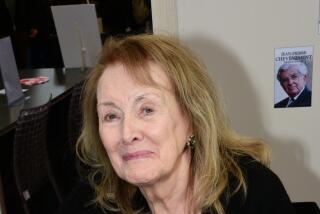Author was expert on history of racism
George Marsh Fredrickson, an authority on the history of racism whose work comparing the histories of South Africa and America helped spawn a new field of study, died Feb. 25 at his home on the Stanford University campus, where he taught for nearly two decades. He was 73.
The cause was heart failure, said his daughter Caroline.
Fredrickson, who was Edgar E. Robinson professor of U.S. history at Stanford when he retired in 2002, wrote several highly regarded books, including “White Supremacy: A Comparative Study in American and South African History” (1981).
A finalist for the Pulitzer Prize, “White Supremacy” examined crucial similarities and differences in the development of apartheid in South Africa and the Jim Crow system of segregation in the American South. It was considered a model of comparative history, “one of the most brilliant and successful . . . ever written,” Yale historian David Brion Davis wrote in the New York Times in 1981.
“He was a pioneer,” Ariela Gross, a professor of law and history at USC who studied for her doctorate under Fredrickson, said this week. “He published ‘White Supremacy’ at a time when most people studying slavery in the United States were doing groundbreaking work but very locally focused, looking at the social history of the U.S. . . . Now everybody is writing about slavery from an Atlantic perspective. Everyone is doing comparative and transnational work, 25 years later.”
Fredrickson’s other books include “The Inner Civil War: Northern Intellectuals and the Crisis of the Union” (1965), “The Black Image in the White Mind: the Debate on Afro-American Character and Destiny” (1971), “Black Liberation: A Comparative History of Black Ideologies in the United States and South Africa” (1995) and “Racism: A Short History” (2002).
His latest book, published last week, is “Big Enough to Be Inconsistent: Abraham Lincoln Confronts Slavery and Race.”
Based on his W.E.B. Du Bois Lectures at Harvard in 2006, the book examines contradictions in the great emancipator’s words and deeds regarding African Americans and the fight against slavery.
Fredrickson was born July 16, 1934, in Bristol, Conn., and grew up in Sioux Falls, S.D. At Harvard, where he earned a bachelor’s degree in 1956 and a doctorate in 1964, he began to think about race; he was influenced by scholars who were writing about the history of black-white relations in the South.
He supported the civil rights movement, joining the historic 1963 March on Washington where the Rev. Martin Luther King Jr. rallied thousands of people of all races with his “I Have a Dream” speech.
Fredrickson’s participation in the movement “spurred him on to . . . grapple with this thing we call racism and understand it in all its manifestations,” said Stanford historian Albert Camarillo, who knew the scholar for more than 25 years.
At Stanford, Fredrickson continued his activism. He participated in an anti-apartheid teach-in at Stanford in 1985 and helped organize a petition signed by 206 faculty members in 1986 that protested the university’s stock holdings in companies doing business with South Africa.
At the time of the petition drive, he told the Mercury News in San Jose that although he had devoted his career to the “rather clinical” study of the development of racism, “there’s a side of me that says that you shouldn’t just study it.”
His studies resulted in works that “should be required reading for anyone concerned with changing the world or creating a better one,” Hazel Rose Markus, a Stanford psychology professor who co-founded with Fredrickson the campus’ Research Institute of Comparative Studies in Race and Ethnicity, said in a statement this week.
Fredrickson spent long stretches in South Africa for research, gathering personal observations that deepened his professional commitment to his subject.
In Cape Town in 1989, he wrote in an essay for the New York Review of Books -- to which he was a frequent contributor -- that he had “the unforgettable experience of riding in unproud isolation on the lower deck of a double-decker bus . . . the top of which was filled to capacity with the black people who had been fortunate enough to get aboard at all. The sight of blacks left on the curb rather than taking seats in the virtually empty ‘white’ part of the bus brought home the meaning of segregation as social humiliation and personal hardship.”
He came to believe that a comparative study of American and South African racism could yield valuable insights and became a leading proponent of such scholarship.
As he said in the introduction to “White Supremacy,” comparative history is “absolutely essential to the enterprise of historical interpretation. How is one to know if a process or development is really the unique product of a special constellation of forces and influences within a given society unless one has actually compared it with analogous cases elsewhere?”
Fredrickson taught at Harvard and Northwestern before joining Stanford in 1984. He served as president of the Organization of American Historians in 1997-98.
In addition to his daughter Caroline of Silver Spring, Md., he is survived by his wife, Helene Osouf, of Stanford; daughters Anne Hope Fredrickson of Grass Valley, Calif., and Laurel Fredrickson of Durham, N.C.; a son, Thomas, of Brooklyn, N.Y.; a sister, Lois Rose, of Great Barrington, Md.; and four grandchildren.
--
More to Read
Sign up for our Book Club newsletter
Get the latest news, events and more from the Los Angeles Times Book Club, and help us get L.A. reading and talking.
You may occasionally receive promotional content from the Los Angeles Times.







